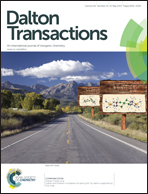Mechanistic insights into the full hydrogenation of 2,6-substituted pyridine catalyzed by the Lewis acid C6F5(CH2)2B(C6F5)2†
Abstract
The reaction mechanism for the full hydrogenation of 2-phenyl-6-methyl-pyridine catalyzed by the Lewis acid C6F5(CH2)2B(C6F5)2 was investigated in detail by density functional theory calculations. Our calculations show that a plausible reaction pathway of the hydrogenation of pyridine contains five stages: (1) the generation of a new borane C6F5(CH2)2B(C6F5)2 from the hydroboration of the alkene, which forms a frustrated Lewis pair (FLP) with a pyridine; (2) the activation of H2 by FLP to yield an ion pair intermediate; (3) intramolecular hydride transfer from the boron atom to the pyridinium cation in the ion pair intermediate to produce the 1,4-dihydropyridine; (4) hydrogenation of the 1,4-dihydropyridine by the FLP to form the 1,4,5,6-tetrahydropyridine; (5) hydrogenation of the 1,4,5,6-tetrahydropyridine by the FLP to yield the final piperidine. The last two hydrogenation processes follow a similar pathway, which includes four steps: (a) proton transfer from the pyridinium moiety to the substrate; (b) dissociation of the newly generated pyridine; (c) hydride migration from the hydridoborate moiety to the protonated substrate to produce the hydrogenated product; (d) release of the hydrogenated product to regenerate the free borane. The full hydrogenation of pyridine is calculated to be exothermic by 16.9 kcal mol−1, relative to the starting reactants. The rate-limiting step is the proton transfer in the second hydrogenation step, with a free energy barrier of 28.2 kcal mol−1 in the gas phase (27.9 kcal mol−1 in toluene) at room temperature and 1.0 atm. Our results can account for the observed experimental facts.


 Please wait while we load your content...
Please wait while we load your content...